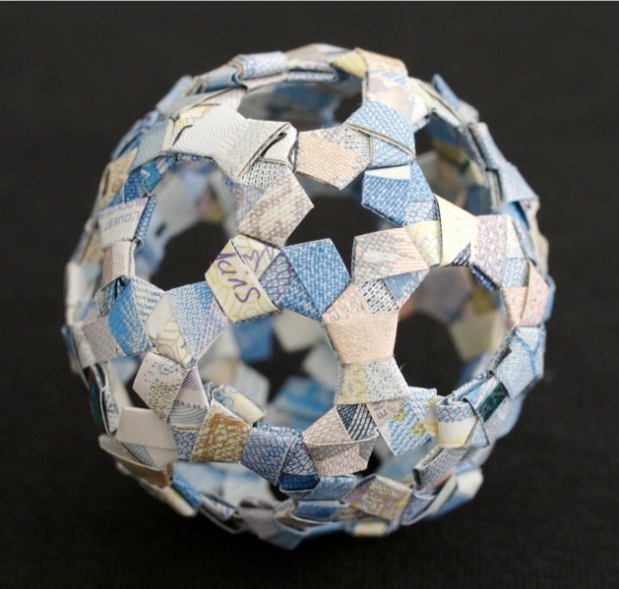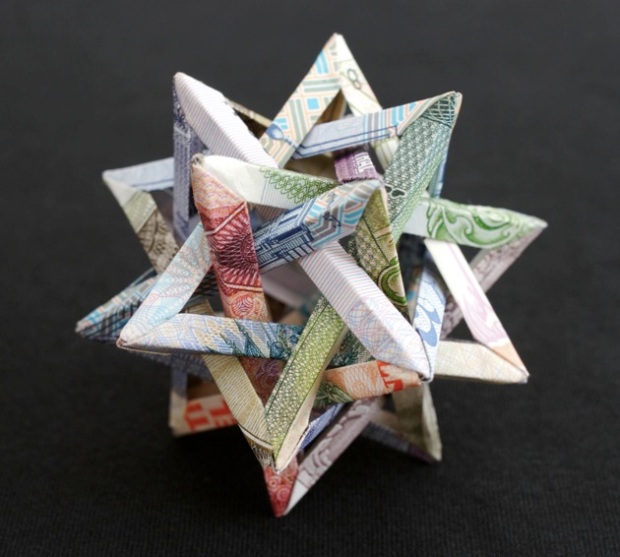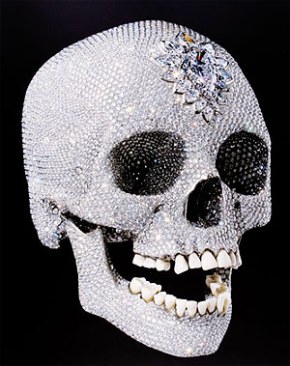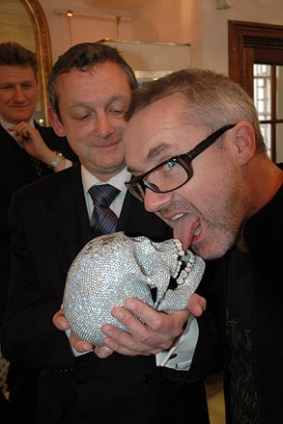All that Glitters: Kristi Malakoff, Damien Hirst, and the Production of Value
by scholastress
An old conference paper I thought I’d throw up on the web. This would represent my growing awareness that Marxism is pretty neat:
One of the key features of late capitalism is the potential for anything – any object, service or affect – to be made reducible to capital, and yet, in this highly monetized schema, the very ideas of money, wealth and value have become increasingly dematerialized. By abandoning the gold standard, currency has detached itself from a physical basis for value, proliferating in the interconnected webs of global currency exchange. As money comes to exist more and more through solely electronic and semiotic means, a crisis seems to emerge concerning the value of currency exchange and the materiality of wealth.[1] While this debate continues in economic and political spheres without signs of clear resolution, contemporary art provides another avenue for thinking through these problems. Kristi Malakoff’s Polyhedra Series (2008) and Damien Hirst’s For the Love of God (2008) can both be seen to engage with the question of wealth and its fragile, historical construction. Malakoff’s work explores the current systems of interdependence and globalization while Hirst’s sculpture can be said to suggest a return to the inherent value of capital and its ritual function as a sacrificial object. In my brief time with you today, I will be exploring these different models of wealth through George Bataille’s concept of expenditure. Equal parts decadence and decay, Malakoff and Hirst’s work provide a telling critique of the contemporary valuation of wealth and trouble its reproduction through a return to the historical ontology of money and its roots in the sacrificial.
Kristi Malakoff is an emerging multidisciplinary artist whose practice is typified by the meticulous dissecting and rearranging of collage material into three dimensional forms. Her Polyhedra Series extends this practice to the use of currency as her artistic materials. Legal tender is cut and folded into kirigami polyhedrons, whose detailed geometries are then displayed in galleries on a mirrored surface.
The variations in Malakoff`s paper sculptures reveal different conceptions of the exchange of currency within a system of economic globalization. With the exception of Canadian Star Ball and Iraqi Bloom, all the polyhedrons are formed from a variety of currencies from different issuing countries. Visually, the more geometric polyhedra shapes reference the use of origami by mathematicians to make abstract Euclidean concepts understandable by hypostatizing formulas into tangible objects.[2] Intersecting Star, for example, is a form used by early mathematicians to measure angles, suggesting the desire of economists to view the movement of capital in mathematically rational terms; to measure the economy and predict it through logical formulas. The names of other pieces, such as Desert Cactus or Honeysuckle, conversely, suggest growth and fecundity, yet the sculptures ultimately achieve the uncanny effect of plastic flowers. Both referents, that of rationality and of harvest, read as fundamentally absurd when read against the fact that Malakoff has utterly arrested the value of the paper bills through their instantiation as art. Malakoff’s deployment of these techniques suggests an attempt to make visible and critique the movements of globalization and economic exchange. The fragility of wealth as representation is made tangible through Malakoff’s destruction of the exchange value of the bills. Malakoff states that her initial intent with the series was to expose the arbitrary way paper currency is understood to have value.[3] By sacrificing the capacity for currency to function as legal tender, Malakoff invites a new modal engagement with money as material object, hinting back to prior epistemic understandings of wealth.
Indeed, the history of currency reveals that this critique of arbitraryness is not without precedent. Michel Foucault most famously describes the shift from metal to paper currency as something of an ontological struggle, a history fraught with questions about the nature of wealth and its value that struck at the epistemological paradigms of an age. First taken as a pledge for gold and silver held in reserve, paper money was originally a mere stand-in for a physical object that had inherent spiritual weight and value. In the Classic age, precious metal was seen to collapse micro and macrocosmic distinctions into sacred unity. Of such metals, Foucault notes, “it reproduces in the depths of the earth that other glitter that sings at the far end of the night: it resides there like an inverted promise of happiness, and, because metal resembles the stars, the knowledge of all these perilous treasures is at the same time knowledge of the world.” Jean-Luc Nancy, another thinker of capital and networks, describes this moment as one of monumental and reverential glitter. The shine to precious metals, he notes, was a “wealth that does not produce more wealth, but which produces its own splendour and its own opulence as the glow of a meaning in which the world is wrapped.”
The cosmological mystery of wealth, however, was lost in the shift towards mercantile economies as the use of currency changed and scepticism towards metal’s otherworldliness mounted. No longer did the possession of money entail the control of objects of immaterial power, instead money became a form of capital, valued in so far as it could lubricate economic exchange.[4] Due to the fluid nature of barter and transactions in this period, Foucault maintains that the domain of currency became analogous to a mere representation of it. Gold held in reserve became secondary to the infinite semiotic possibilities of kinetic capital, stored in paper currency. From one representation to another, money could no longer be said to signify autonomously, but rather but express and necessitate the simple and endless possibility of exchange.[5]
Modern fiat money clearly functions in this paradigm, as exchange rates influence the relative buying power of currency, explicitly through their comparative standing in the global market. The sign of the currency (a dollar or pound sign, for example) is sufficient to signify exchange value. The exact referent behind the sign is unclear, and moreover, unnecessary for the system of exchange within which the money operates. In recent years the semiotic hollowness of this system has increasingly come into question though protests at the American Federal Reserve and in the American legal system.[6] Several recent court cases, for example, have responded to individual American citizen’s appeals that federal reserve notes are not real dollars, and as such do not constitute taxable income. The recent Republic presidential candidate race, moreover, featured several candidates who variously articulated a need to return to the gold standard. Malakoff’s practice can thus be seen as responding to a larger anxiety about the immateriality of currency and capital.
Malakoff was initially inspired to explore currency as an artistic medium after reading Walter Benjamin’s “The Work of Art in the Age of Mechanical Reproduction,” a famous critique of mass media prints for the loss of the special aura that was unique to the original art object.[7] Malakoff approaches paper money as an important analog to Benjamin’s art reproductions, seeing currency as a shallow copy of eroded monetary and national values.[8] Whereas Benjamin’s raises political concerns about the potential for fascist appropriation of art in its fragmented state of reproduction, Malakoff’s critique is equally political, describing currency as a form of propaganda.[9] Her practice is thus framed as one of appropriation and also, critically, of salvage; by subverting the political ideals represented on the currency she thus attempts to restore the aura of the art object.[10] This aura, described by Benjamin a quality of presence, authenticity, and authority of the object, suggests the critical role that material ontology plays in wresting art or money from its degradation into ideological exchange.
Removing money from this system of exchange, however, is a highly prohibited act. Not only is there a very blatant monetary cost to sourcing the Polyherdra’s materials, there is something quite transgressive in Malakoff’s destruction of the monetary value of the bills. Such acts are, quite literally, illegal as tender cannot be lawfully destroyed save by sanctioned banks and government institutions. The supposed immorality at sacrificing money, however, must be assumed to be more than legal. Political economists such as Carl Wennerlind suggest that in addition to mediating economic exchange, money plays a vital part in constructing and enforcing social order, in spite of its semiotic fragility. A shared currency or monetary system, like a shared language, entails a trust in the mutual understanding of the sign value of a bill and a common investment in maintaining money as a social unit.[11] In capitalism, Wennerlind thus suggests, currency thus takes on the signifying potential of social power and command, becoming a “fetishized symbol of force” eerily detached from connotations of violence.[12] Malakoff’s destruction of contemporary money thus becomes a politically charged act, opposing herself to the capitalist system that reifies exchange value and disciplines the public body through the social command of currency.[13]
This interdiction also aligns Malakoff with the philosophy of George Bataille, a french writer whose conception of dépense, or expenditure, radically refigures capitalist systems of value. Classifying economic systems on the basis of how their seemingly perpetual energy inputs are spent, Bataille reclassifies expenditure as the most important human activity.[14] He proposes two different energy systems: the restrictive economy (which seeks to continually reinvest wealth in the production of further capital and exchange) and the general economy (which seeks to ritually expend its surplus in sacrificial acts that ritually and irrevocably destroy energy and wealth).[15] In his analysis- which one should note closely followed the second World War- the general economy was infinitely preferred to the restrictive economy as the reinvestment and accumulation of energy in the latter was seen to build up, as if under pressure, until it inevitably burst forth in a violent outpouring of war. Bataille particularly celebrated the models of the potlach[16] and the excessive decadence of the aristocracy as examples of the general economy while the industrial machines of capitalism were conversely affiliated with the restrictive economy’s pursuit of perpetual growth. Contemporary late capitalism, moreover, presents an intensification of this tendency, such that virtually all expenditure is recycled and optimized, save for perpetual outbursts of violent industrial disasters.
Reading Bataille and his theories into the Polyhedra Series, Malakoff and her strategies of destruction can be seen as clearly allied with the general economy. By refusing to enact the exchange and reinvestment of currency, Malakoff’s expenditure of money beyond its recoverability as capital is thus a political and epistemological challenge to the self-interested virtues of late capitalism.
Now, discussions of wealth are certainly a well-trodden path when comes to the work of Damien Hirst, the face of the Young British Artists and likely the richest artist alive.[17] He also has the distinction of creating the world’s most expensive piece of art by a living artist, For the Love of God, which sold for fifty million pounds to a consortium of anonymous investors that included the artist himself. The piece is a platinum cast of an eighteenth century skull (of which only the teeth remain) that has been covered in precisely eight thousand six hundred and one diamonds, themselves valued at over ten million pounds.[18] The title is supposedly the reaction of Hirst’s mother after hearing what her son proposed to do. The monetary expenditure that went into the production of the piece seems, frankly, vulgar, yet it is this aspect of the work that may be key to positioning its conceptual gesture towards capital and value.
As in Malakoff, Hirst displays wealth in an ostentatious fashion while stressing the material qualities of wealth as a key component of its value. Diamonds and platinum, contrary to fiat money, seem to inherently retain the epistemological value of glitter enumerated by Foucault and Nancy. Their sparkle and luminosity in addition to their physical objecthood, imbues them with value in excess of exchange economies. Hirst’s mobilization of the work, however, is explicitly engaged with the capitalist art market, and as such, these qualities are brought into sharp tension with the mobile, immaterial economy of commodities. Flirting between the general and restrictive economies, For the Love of God is thus a risky proposition by Hirst that verges on the sacrificial.
Contemporary viewers, however, may have a hard time moving past the exorbitant price of the work. The incomprehensible expense buying the artwork for fifty-million pounds, or Hirst’s own equally unintelligible disbursement of over ten-million pounds for the construction of the piece, has the tendency to forbid intellectual thought through its sheer display of wealth. Hirst seems to foresee this effect in his preparatory drawings, writing, “it’s not gonna be cheap laddy!!/The best quality fucking diamonds money can buy/I AM NUTS.”[19] Hirst makes light of his efforts, perhaps as a strategy to negotiate the obscenity of the expenditure of the work, or to excuse its incongruity with the capitalist figuration of art. Nevertheless, Hirst conceives of a key aspect of his work, one which upon reflection moves the viewer into a greater field of interpretation.
This stumbling block, sometimes referred to as the “the capitalist sublime,”[20] is an aesthetic confrontation with the capitalist ideal of infinite wealth.[21] This mismatch between the imagination and the understanding, a clashing of the faculties in the material presentation of the immaterial, may be part of the reason why the critical discourse on this piece so rarely supersedes a discussion of its vulgarity.[22]
While both Hirst and Malakoff effect a destruction of contemporary moral and economic standards, the two works still enact a strong point of tension between one another through the means by which value is shifted and exchanged. The monetary cost of Malakoff’s polyhedra is infinitesimally smaller than Hirst’s, yet the large amount of skilled labour she expends in their making gives the kirigami a sense of worth well beyond the fiscal costs of skilled production. Hirst, conversely, did not make the skull himself. Operating from a more conceptual praxis of art, Hirst coordinated the work’s production but contributed little by way of personal physical labour.
Another significant point of contrast lies in how the record-breaking price of Hirst’s work is of tantamount concern to how it is framed as valuable. While both Malakoff and Hirst’s works expend capital sacrificially to realize an artwork with greater material and philosophical value, critically, Hirst’s needs to be priced and sold in order to gain the full nuance of its meaning. Quite tellingly, attacks on the work have taken the shape of contesting its monetary worth, arguing that the piece is more accurately priced at a less impressive seven to ten million pounds.[23]
Art history does not typically consider a work’s capital value as a legitimate field of analysis, yet in circumstances such as these, there is a critical need to regard the commercial aspects of art as belong to the same order of values as the aesthetic.[24] This is, however, not to say that Hirst’s work has more merit than Malakoff’s due to its selling price, but it does, however, open up the mechanics of the sale of art as an interesting avenue of interpretation. The Polyhedra Series, circulating primarily in the artist-run gallery circuit, seems to intellectually oppose its own sale, in accord with the anti-capitalist themes of the work. While some works have definitely been priced and sold, the commercial life of the artwork remains hidden from view and in effect, disavowed. For the Love of God, conversely, was aggressively marketed by Hirst’s dealers, who fully anticipated its sale at its present exorbitant price or even higher. Interestingly, speculation has emerged as to the veracity of this sale. The anonymity of the consortium of buyers and lack of taxes paid on the purchase has suggested to a few bitter voices in the art world that Hirst failed to move the skull and in turn perpetuated a hoax sale to save face.[25]
I would like to argue that For the Love of God is an infinitely more valuable object if we presume that it has failed as a commodity. The sale of the work, rather than being a sole test of the buying power of Hirst’s artistic brand, also staged a challenge to the models of value figured in the material wealth with which the skull was made and the immaterial wealth which was supposed to have secured the skull’s stature as a commodity, recouping Hirst’s expenditure into the restrictive economy. Supposing, however, that the sale failed, we are confronted with an artwork whose obdurate materiality can only be an object of expenditure without reserve. In an attempt to defeat death through glitter, Hirst appears to have lost millions of pounds and created an object that cannot be sold.
Reflecting on the themes of this conference, one might see both the decadent display of material wealth and the decay of its exchange value as viable aesthetic strategies with which to confront the economic conditions of late capitalism. As noted by Jean-Luc Nancy, the struggle to form a world is more often the struggle of capital against itself;[26] a struggle that is well represented in the work of Malakoff and Hirst. This endeavor, when reduced to its most basic components, is fundamentally a conflict over the understanding of value, be it the epistemological glitter of material wealth or the semiotic hollowness of an infinitely exchangeable sign. For the Love of God and the Polyhedra Series paradoxically re-materialize wealth by arresting its exchange value. Hirst takes wealth back to its classical materiality, while creating a paradigm of expenditure in contemporary art. Malakoff succeeds in taking contemporary paper currency further in this direction, while illustrating the crisis of value in the global economy. Meaning is created through expenditure and arresting wealth to make visible its contradictions and fragilities.
[1] United States Department of Justice,“Criminal Tax Manual: 40.0: Illegal Tax Protestors,” United States Department of Justice Reading Room, accessed December 7th 2010, http://www.justice.gov/tax/readingroom/2001ctm/40ctax.htm.
–[2]Leah Turner, “What it Really Is,” C Magazine 27 (Summer 2009): 51.
–[3]Kristi Malakoff, Blazzamo, Artist lecture presented at Latitude 53 Gallery, Edmonton, AB, November 13 2010.
–[4]Ibid., 178.
[5]Ibid., 179-180.
[6]Internal Revenue Service, “The Truth About Frivolous Tax Arguments: Contention: Federal Reserve Notes are not Income,” Internal Revenue Service, United States Department of the Treasury, accessed December 7th 2010, http://www.irs.gov/taxpros/article/0,,id=159932,00.html#_Toc224375587.
[7]Malakoff, Blazzamo.
[8]Ibid.
[9] Malakoff, Blazzamo.
[10] Ibid.
[11] Ibid., 560.
[12] Ibid., 567.
[13] Ibid.
–[14] George Bataille, “The Meaning of the General Economy,” trans. Robert Hurley, in The Bataille Reader, eds. Fred Bottling and Scott Wilson (Oxford: Blackwell Publishing, 1998), 185.
–[15]Ibid, 186.
–[16] Bataille, “The Notion of Expenditure,” trans. Allan Stoekl with Carl R. Lovitt and Donald M. Leslie, Jr., in The Creation of the World, or Globalization,trans. Françoi Raffoul and David Pettigrew (Albany: State University of New York Press, 2007), 171-174.
–[17]Pernilla Holmes, “The Branding of Damien Hirst,” ARTnews, October 2007, http://www.artnews.com/issues/article.asp?art_id=2367
–[18]Ibid.
[19] Hirst, Fuchs, and Beard, For the Love of God, 75.
–[20]Luke White, “Damien Hirst and the Legacy of the Sublime in Contemporary Art and Culture”, (PhD dissertation, Middlesex University, 2009), 406.
–[21]Jean-Francois Lyotard, “The Sublime and the Avant Guard,” in Postmodernism: A Reader, ed. Thomas Docherty, (New York: Columbia University Press, 1993), 255.
–[22]White, “Damien Hirst and the Legacy of the Sublime,” 406-408.
[23] Owen and Dunbar, “Did Damien Hirst Really..?”
[24] Carter Ratcliff, “The Marriage of Art and Money,” Art in America 76 (July 1988): 85.
[25] Glen Owen and Polly Dunbar, “Did Damien Hirst Really Sell His Diamond Skull for £50m?” Mail Online, 09 September 2007, accessed 07 December 2010, http://www.dailymail.co.uk/news/article-480729/Did-Damien-Hirst-really-sell-diamond-skull-50m.html.
–[26]Nancy, “Urbi et Orbi,” 51.



